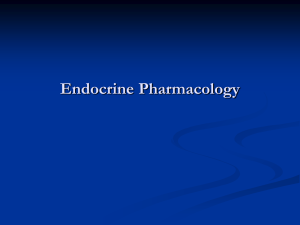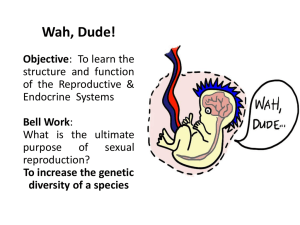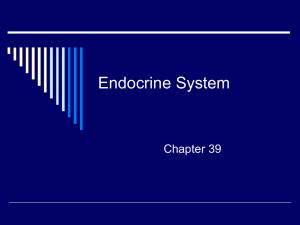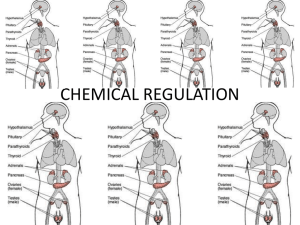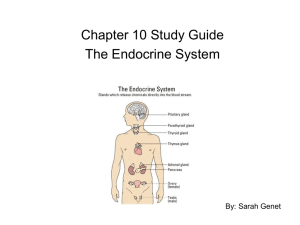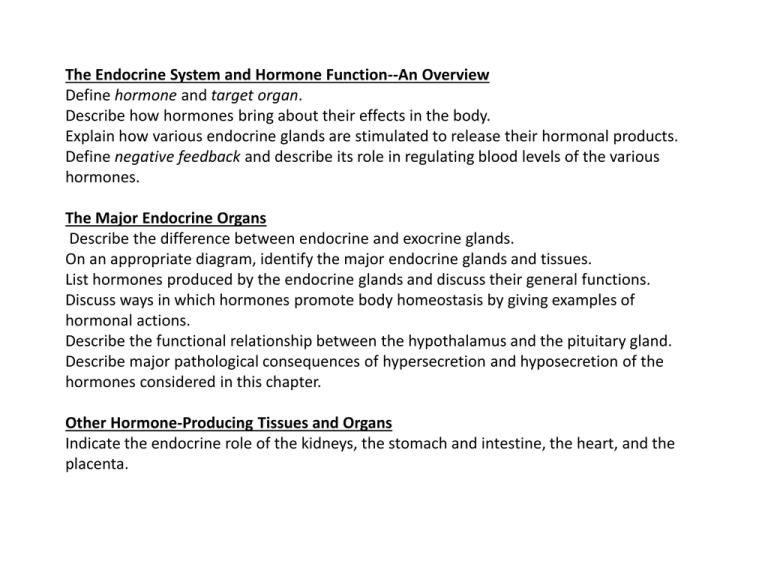
The Endocrine System and Hormone Function--An Overview
Define hormone and target organ.
Describe how hormones bring about their effects in the body.
Explain how various endocrine glands are stimulated to release their hormonal products.
Define negative feedback and describe its role in regulating blood levels of the various
hormones.
The Major Endocrine Organs
Describe the difference between endocrine and exocrine glands.
On an appropriate diagram, identify the major endocrine glands and tissues.
List hormones produced by the endocrine glands and discuss their general functions.
Discuss ways in which hormones promote body homeostasis by giving examples of
hormonal actions.
Describe the functional relationship between the hypothalamus and the pituitary gland.
Describe major pathological consequences of hypersecretion and hyposecretion of the
hormones considered in this chapter.
Other Hormone-Producing Tissues and Organs
Indicate the endocrine role of the kidneys, the stomach and intestine, the heart, and the
placenta.
Define hormone and target organ
• Hormone: A chemical substance produced in
the body that controls and regulates the
activity of certain cells or organs.
• Target organ: A tissue or organ upon which a
hormone exerts its action; generally, a tissue
or organ with appropriate receptors for a
hormone.
Describe how hormones bring about
their effects in the body.
• Changes in plasma membrane permeability or
electrical state
• Synthesis of proteins, such as enzymes
• Activation or inactivation of enzymes
• Stimulation of mitosis
• Promotion of secretory activity
The Chemistry of Hormones
• Hormones are classified chemically as
1. Amino acid–based, which includes
• Proteins, Peptides, Amines
2. Steroids—made from cholesterol; sex hormones
made by gonads & hormones of adrenal cortex
Local Hormones:
– Prostaglandins—made from highly active lipids
released by nearly all cell membranes
Direct Gene Activation
(Steroid Hormone Action)
1.
Diffuse through the
plasma membrane of
target cells
2.
Enter the nucleus
3.
Bind to a specific
protein within the
nucleus
4.
Bind to specific sites
on the cell’s DNA
5.
Activate genes that
result in synthesis of
new proteins
Second-Messenger System
(Nonsteroid Hormone Action)
1.
2.
3.
4.
5.
Hormone binds to a
membrane receptor
Hormone does not enter
the cell
Sets off a series of
reactions that activates an
enzyme
Catalyzes a reaction that
produces a secondmessenger molecule
Oversees additional
intracellular changes to
promote a specific
response
Explain how various endocrine glands are
stimulated to release their hormonal products
1. Hormonal Stimuli- Endocrine glands are
activated by other hormones
2. Humoral Stimuli-Changing blood levels of
certain ions stimulate hormone release
3. Neural Stimuli-Nerve impulses stimulate
hormone release; Most are under the control of
the sympathetic nervous system
Hormonal Stimuli of Endocrine Glands
• Most common stimuli
• Endocrine glands are
activated by other
hormones
• Examples:
– Anterior pituitary
hormones
Figure 9.2a
Humoral Stimuli of Endocrine Glands
• Changing blood levels
of certain ions
stimulate hormone
release
•
Humoral indicates various body fluids
such as blood and bile
• Examples:
– Parathyroid hormone
– Calcitonin
– Insulin
Figure 9.2b
Neural Stimuli of Endocrine Glands
• Nerve impulses
stimulate hormone
release
• Most are under the
control of the
sympathetic nervous
system
• Examples include:
the release of
norepinephrine and
epinephrine by the
adrenal medulla
Figure 9.2c
Define negative feedback and describe its role in
regulating blood levels of the various hormones.
• Negative feedback
– Includes most homeostatic control mechanisms
– Shuts off the original stimulus, or reduces its
intensity
• Hormone secretion is triggered by a stimulus or low
hormone levels in the blood triggers the release of
more hormone
• Hormone release stops once an appropriate level in
the blood is reached
Describe the difference between
endocrine and exocrine glands.
• Two major gland types
– Endocrine gland
• Ductless since secretions diffuse into blood vessels
• All secretions are hormones
– Exocrine gland
• Secretions empty through ducts to the epithelial
surface
• Include sweat and oil glands
On an appropriate diagram, identify the major
endocrine glands and tissues.
List hormones produced by the endocrine
glands and discuss their general functions.
1.
2.
3.
4.
5.
6.
7.
8.
Pituitary gland
Thyroid gland
Parathyroid glands
Adrenal glands
Pineal gland
Thymus gland
Pancreas
Gonads (Ovaries
and Testes)
9. Hypothalamus
Hormones of the Anterior Pituitary
Figure 9.4
Hormones of the Posterior Pituitary
Figure 9.6
Thyroid Gland
• Thyroid hormone
– Major metabolic
hormone
– Composed of two active
iodine-containing
hormones
• Thyroxine (T4)—secreted by
thyroid follicles
• Triiodothyronine (T3)—
conversion of T4 at target
tissues
• Calcitonin
– Decreases blood calcium
levels by causing its
deposition on bone
– Antagonistic to
parathyroid hormone
– Produced by
parafollicular cells
– Parafollicular cells are
found between the
Figure 9.7a
follicles
Hormones of the Adrenal Cortex
Hormones of the Adrenal Medulla
Two similar hormones (catecholamines)
Epinephrine (adrenaline)
Norepinephrine (noradrenaline)
Hormones of the Adrenal Cortex
• Mineralocorticoids (mainly aldosterone)
• Glucocorticoids (cortisone and cortisol)
• Sex hormones(Mostly androgens (male sex hormones)
some estrogens (female sex hormones)
Figure 9.11
Hormones of the Adrenal Cortex
• Mineralocorticoids (mainly
aldosterone)
– Produced in outer adrenal
cortex
– Regulate mineral content in
blood
– Regulate water and electrolyte
balance
– Target organ is the kidney
– Production stimulated by renin
and aldosterone
– Production inhibited by atrial
natriuretic peptide (ANP)
Figure 9.12
Hormones of the Adrenal Cortex
• Glucocorticoids (including cortisone and
cortisol)
– Produced in the middle layer of the adrenal cortex
– Promote normal cell metabolism
– Help resist long-term stressors
– Released in response to increased blood levels of
ACTH
Hormones of the Adrenal Cortex
• Sex hormones
– Produced in the inner layer of the adrenal cortex
– Small amounts are made throughout life
– Mostly androgens (male sex hormones) are made
but some estrogens (female sex hormones) are
also formed
Hormones of the Adrenal Medulla
• Produces two similar hormones
(catecholamines)
– Epinephrine (adrenaline)
– Norepinephrine (noradrenaline)
• These hormones prepare the body to deal
with short-term stress (“fight or flight”) by
– Increasing heart rate, blood pressure, blood
glucose levels
– Dilating small passageways of lungs
Roles of the Hypothalamus and
Adrenal Glands in the Stress Response
Short term
More prolonged
Stress
Hypothalamus
Nerve impulses
Releasing hormone
Corticotropic cells of
anterior pituitary
Spinal cord
Preganglionic
sympathetic
fibers
ACTH
Adrenal
cortex
Adrenal
medulla
Mineralocorticoids
Catecholamines
(epinephrine and
norepinephrine)
Short-term
stress response
1. Increased heart rate
2. Increased blood pressure
3. Liver converts glycogen to
glucose and releases glucose
to blood
4. Dilation of bronchioles
5. Changes in blood flow
patterns, leading to increased
alertness and decreased
digestive and kidney activity
6. Increased metabolic rate
Glucocorticoids
Long-term stress response
1. Retention of sodium
and water by kidneys
2. Increased blood
volume and blood
pressure
1. Proteins and fats
converted to glucose
or broken down for
energy
2. Increased blood
sugar
3. Suppression of
immune system
Figure 9.13
Pineal Gland
• Found on the third ventricle of the
brain
• Secretes melatonin
– Helps establish the body’s wake and
sleep cycles
– Believed to coordinate the hormones
of fertility in humans
Thymus Gland
• Located posterior to
the sternum
• Largest in infants and
children
• Produces thymosin
– Matures some types of
white blood cells
– Important in developing
the immune system
Pancreatic Islets
•
•
The pancreas is a mixed gland and has both
endocrine and exocrine functions
The pancreatic islets produce hormones
– Insulin—allows glucose to cross plasma
membranes into cells from beta cells
– Glucagon—allows glucose to enter the blood from
alpha cells
– These hormones are antagonists that maintain
blood sugar homeostasis
Gonads
• Ovaries
– Produce eggs
– Produce two groups
of steroid hormone
• Estrogens
• Progesterone
• Testes
– Produce sperm
– Produce androgens,
such as testosterone
Hormones of the Ovaries
• Estrogens
– Stimulate the development of secondary female
characteristics
– Mature female reproductive organs
• With progesterone, estrogens also
– Promote breast development
– Regulate menstrual cycle
• Progesterone
– Acts with estrogen to bring about the menstrual cycle
– Helps in the implantation of an embryo in the uterus
– Helps prepare breasts for lactation
Hormones of the Testes
• Produce several androgens
• Testosterone is the most important androgen
– Responsible for adult male secondary sex
characteristics
– Promotes growth and maturation of male
reproductive system
– Required for sperm cell production
Discuss ways in which hormones promote body
homeostasis by giving examples of hormonal actions.
• Homeostasis—maintenance of a stable internal
environment
Hormonal Regulation of Calcium in
Blood
Calcitonin
stimulates
calcium salt
deposit
in bone
Calcitonin
Thyroid gland
releases
calcitonin
Thyroid
gland
Rising
blood
Ca2+
levels
Calcium homeostasis of blood
9–11 mg/100 ml
Falling
blood
Ca2+
levels
Thyroid
gland
Osteoclasts
degrade bone
matrix and release
Ca2+ into blood
Parathyroid
glands
PTH
Parathyroid
glands release
parathyroid
hormone (PTH)
Figure 9.10
Hormonal Regulation of Blood Glucose
Describe the functional relationship between
the hypothalamus and the pituitary gland.
• Hormonal release by pituitary is regulated by
releasing and inhibiting hormones produced by
the hypothalamus
• Hypothalamus produces two hormones
• These hormones are transported to
neurosecretory cells of the posterior pituitary
– Oxytocin
– Antidiuretic hormone
• The posterior pituitary is not strictly an endocrine
gland, but does release hormones
Describe major pathological consequences of
hypersecretion and hyposecretion of the hormones
considered in this chapter.
•
Growth hormone (GH) disorders
– Pituitary dwarfism results from hyposecretion of GH during childhood
– Gigantism results from hypersecretion of GH during childhood
– Acromegaly results from hypersecretion of GH during adulthood
•
•
Thyroid Gland
Goiters
– Thyroid gland enlarges due to lack of iodine
– Salt is iodized to prevent goiters
•
Cretinism
– Caused by hyposecretion of thyroxine
– Results in dwarfism during childhood
•
Myxedema
– Caused by hypothyroidism in adults
– Results in physical and mental slugishness
•
Graves’ disease
– Caused by hyperthyroidism
– Results in increased metabolism, heat intolerance, rapid heartbeat, weight loss, and
exophthalmos
• Adrenal Glands
• Adrenal cortex disorders
• Addison’s disease
– Results from hyposecretion of all adrenal cortex hormones
– Bronze skin tone, muscles are weak, burnout, susceptibility to
infection
• Hyperaldosteronism
– May result from an ACTH-releasing tumor
– Excess water and sodium are retained leading to high blood
pressure and edema
• Cushing’s syndrome
– Results from a tumor in the middle cortical area of the adrenal
cortex
– “Moon face,” “buffalo hump” on the upper back, high blood
pressure, hyperglycemia, weakening of bones, depression
Indicate the endocrine role of the kidneys, the stomach
and intestine, the heart, and the placenta.
Table 9.2 (2 of 2)



